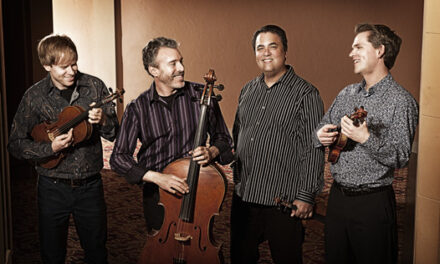Regardless of how magnificent a singer is, the presence (or absence) of great musicians accompanying the vocalist usually makes the difference between a good and a memorable performance. There was no mention of the band members that would support Dianne Reeves‘ appearance at Memorial Hall in Carolina Performing Arts‘ publicity or program. Once the lineup was announced – by a bodiless voice at Memorial – it was clear that this was an elite group of seasoned pros, and this was to be a great concert. Not a difficult prediction.
Out came Peter Martin, piano, Reginald Veal, upright bass and bass guitar, Terreon Gully, drums, and Romero Lubambo, acoustic and electric guitars. Before the headliner appeared, they played – as a quartet – the Gershwin classic “Summertime” from Porgy and Bess. This is one of the great works of art from the American Songbook, and these four musicians did what great artists should do: put some of their own identity into a well-known work while still retaining the attributes of the original.
They started another song and already there was some concern that, despite the greatness of the players, they’d be playing half the set without Reeves, but then she stepped out to thunderous applause and we were on our way to a great collection of tunes – including a few that ordinarily might seem out of place for a jazz singer.
Some recordings are so ingrained in your mind that when you hear them done by someone else, a form of musical confusion sets in. This was the case with the first song, which took me a while to identify. (There were no program notes!) Finally, it clicked: the Fleetwood Mac megahit “Dreams,” composed and sung by Stevie Nicks. This was a wonderful arrangement that in no way reminded you of the original. Although Reeves never subscribed to the “jazz only” rule in selecting her songs, her new signing with Concord Records and her first release on that label, Beautiful Life, pushes her eclecticism even further. This concert was a great example of this wide range of styles and influences.
Reeves has an amazing vocal range, effortlessly going from a deep sultry alto to the upper reaches of a soprano’s notes. Even more importantly, it all sounds natural and musically appropriate. Combine that with her authentic performances of soul, Latin, R&B, pop, and jazz and you have a singer who can perform just about anything. She also judiciously and tastefully uses the scat technique (wordless vocalizations like an instrumentalist).
From the 1970s rock hit “Dreams” Reeves moved to “Stormy Weather,” one of the iconic female jazz classics. There are some jazz singers who, in attempting to personalize their interpretation, completely obliterate all aspects of what made the song great in the first place: melody, harmony, rhythm, and even lyrics. This was an example of someone definitely marking their territory on a well-worn classic but still retaining at least some of the original elements.
Then came an initially unidentifiable selection that was in an Afro-Cuban style, sung as a vocalise. Only at the very end did Reeves identify it as an homage to Celia Cruz, a Cuban-American singer who was one of the great proponents of salsa and other Latin forms. Reeves sang this as an example of a singer she listened to all her life but from whom she never understood the actual words. Cruz’s stage presence and musicianship said everything she needed to know.
One of the huge milestones in Reeves’ career was her fairly large on-camera role in the 2006 movie Good Night, and Good Luck, written, directed by, and starring George Clooney. Reeves includes a story about the film and a song from it at nearly every one of her concerts. On this occasion, it was Harold Arlen’s consummate “tears in my beer” ballad, “One For My Baby.” But rather than a maudlin, self-pitying confessional, this was played as an up-tempo blues that allowed all the members of the band to let loose. The final solo had Romero Lubambo play some blazing rock, showing again that this fabulous guitarist can do just about anything. It’s apparent that he and Reeves have a special musical affinity, and her affection for him was obvious as she referred to him as “a brother from another mother.”
Which brings me to what I thought was the highlight of the evening: a stunning Reeves/Lubambo duo on the 1938 Gershwin standard “Our Love is Here to Stay.” Lubambo, arguably the finest relatively unknown living guitarist, moved through Brazilian, straight-ahead jazz, and blues styles in a display of musical joy and virtuosity. Then, one by one, each member of the band came back and had a chance to brag about their chops.
The evening, all too briefly, wound down.
It took some hand-clapping pleading, but Reeves relented and returned for a single encore with just her pianist, Peter Martin. They played the quiet, introspective “You Taught My Heart to Sing,” by Sammy Cahn and McCoy Tyner. Near the end Reeves put down her microphone and sang un-plugged as she walked off the stage. Nice effect.
Well, I’m going to go ahead and rant a bit about what I consider a troubling trend. As consumers, we’ve all seen the insidious practice of the shrinking packaging. You’re paying more, and it appears what you get is the same amount you always had, but you’re actually getting less and less. I’m not comparing great musicians to a box of cereal, but I’ve noticed that most jazz and pop concerts are now performed without an intermission, and the playing time is often shrinking. Not counting the quartet alone at the start of this concert, Reeves performed for about 50 minutes. With escalating ticket costs, parking fees, etc., it seems that, as far as time exposure to these artists is concerned, we are getting short-changed.











